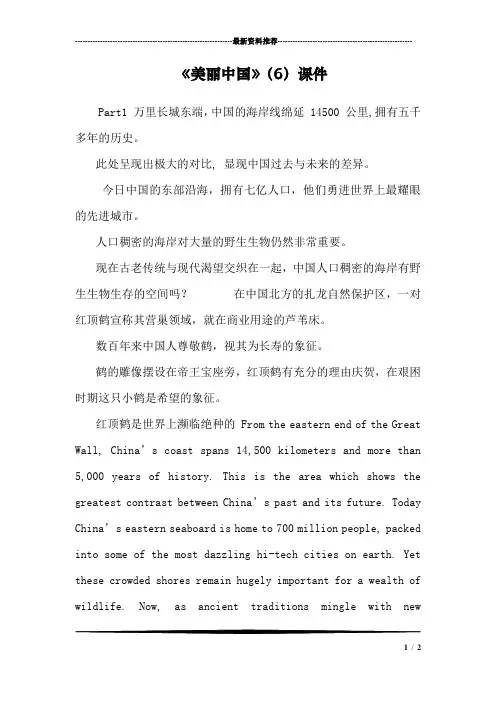美丽中国PPT教学资料
- 格式:ppt
- 大小:1.69 MB
- 文档页数:40


---------------------------------------------------------------最新资料推荐------------------------------------------------------《美丽中国》(6)课件Part1 万里长城东端,中国的海岸线绵延 14500 公里,拥有五千多年的历史。
此处呈现出极大的对比, 显现中国过去与未来的差异。
今日中国的东部沿海,拥有七亿人口,他们勇进世界上最耀眼的先进城市。
人口稠密的海岸对大量的野生生物仍然非常重要。
现在古老传统与现代渴望交织在一起,中国人口稠密的海岸有野生生物生存的空间吗?在中国北方的扎龙自然保护区,一对红顶鹤宣称其营巢领域,就在商业用途的芦苇床。
数百年来中国人尊敬鹤,视其为长寿的象征。
鹤的雕像摆设在帝王宝座旁,红顶鹤有充分的理由庆贺,在艰困时期这只小鹤是希望的象征。
红顶鹤是世界上濒临绝种的 From the eastern end of the Great Wall, China’s coast spans 14,500 kilometers and more than 5,000 years of history. This is the area which shows the greatest contrast between China’s past and its future. Today China’s eastern seaboard is home to 700 million people, packed into some of the most dazzling hi-tech cities on earth. Yet these crowded shores remain hugely important for a wealth of wildlife. Now, as ancient traditions mingle with new1 / 2aspirations, is there any room at all for wildlife on China’s crowded shores? In northern China’s Zhalong Nature Reserve, a pair of red-crowned cranes have staked out their nesting territory in the stubble of a commercially managed reed bed. For centuries, cranes have been revered in China as symbols of longevity. Their statues were placed next to the Emperor’s throne. The cranes have cause to celebrate. This chick is a sign of hope in difficult times. Red-crowned cranes are one of the world’s most endangered species. Over the last century, China has lost nearly half of its coastal wetlands and most of what remains is managed for the benefit of people, not wildlife. A few months from now, this chick and its parents will face a long migration south 物种之一。







